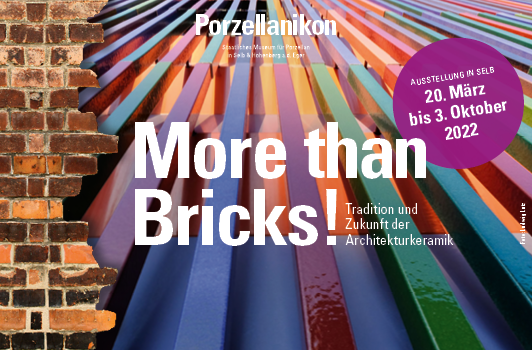PORZELLANIKON SELB OFFERS NEW SCHOOL PROGRAMMES
The famous Lego building blocks can be found in practically every child's room. Children use them to practise building houses, castles, entire cities and fan-tastic worlds in miniature. The current special exhibition "MORE THAN BRICKS! Tradition and Future of Architectural Ceramics" (until 3 October 2022 at Porzellanikon Selb) takes advantage of this to teach even the youngest schoolchildren about the unique role and effect of ceramics in architecture. In this way, even the youngest children learn that architecture and architectural ceramics belong together and shape our lives because they are part of our everyday lives. Architecture is included in school curricula from primary school to grammar school in many subjects, such as history, social studies, local history and science, handicrafts and design, geography and art. The current school programmes for the special exhibition are therefore adapted to the respective curricula of almost all grades of primary, special, middle and secondary schools as well as grammar schools. Participation costs 5 euros per pupil, the programmes last two and a half hours and take place at Porzellanikon Selb.
Offer for the little ones: Selbling City
The museum educators have developed "Selbling City" for children from the 1st grade upwards. "Here, the little ones slip into the role of city planners, they tinker and build a miniature city out of Lego bricks," explains the head of education and outreach, Christoph Uhlig. What the inhabitants of a small city need and want, how colours and shapes influence the cityscape - these and other questions are playfully explored and explained by our museum educators.
From Year 5: Bricklaying with mini bricks and tile pictures design
In the first school programme, the pupils brick themselves with mini bricks and mortar and experiment with this building technique. How do you have to lay bricks to make a house stable? How do you conjure up patterns on a façade with bricks? The little ones learn the answers to these questions through play. "We get inspired by brick buildings in the special exhibition and then get to work," explains Christoph Uhlig. In the process, the pupils' love of experimentation and teamwork are just as much challenged as creativity and a steady hand.
When designing tile pictures, the pupils try their hand at being porcelain artists, testing the almost infinite possibilities for embellishing buildings. Particularly impressive are large wall mosaics, which are made up of many small tiles like a jigsaw puzzle. Under the guidance of the museum educators, the pupils learn how a sketch becomes a gigantic façade painting. "Our young guests either paint empty tiles or work on cast porcelain plates," says Christoph Uhlig. They start by creating a common motif, which is then divided into individual tiles. In this way, everyone makes their creative contribution and produces their part of the overall picture.
The school programmes can be booked by phone at 09287 91800666 or by e-mail at museumspaedagogik(at)porzellanikon.org .
Teachers can find detailed information on the school programmes at https://www.porzellanikon.org/ausstellungen/sonderausstellungen/more-than-bricks/.
https://www.porzellanikon.org/ausstellungen/sonderausstellungen/more-than-bricks/
- Files:
 2022.03.28_PM_Schulprogramme_EN.pdf723 K
2022.03.28_PM_Schulprogramme_EN.pdf723 K






Share Porzellanikon with Friends